Difference between revisions of "Rocket Engines"
| Line 34: | Line 34: | ||
Examples of this style of rocket engine are the RD-180 and the BE-4. | Examples of this style of rocket engine are the RD-180 and the BE-4. | ||
===Fuel-rich, Closed-Cycle, Staged-Combustion Engine=== | ===Fuel-rich, Closed-Cycle, Staged-Combustion Engine=== | ||
A fuel rich dual staged combustion closed cycle is similar in concept, but much more difficult in execution to the already complex oxygen rich staged combustion closed cycle engine. In the fuel rich closed cycle engine design, all of the fuel is sent to the two preburners, and the oxidizer is sent to the preburners as well as the main combustion chamber. Super-heated, fuel-rich exhaust is then directed from the preburner to the main combustion chamber. The advantage to this setup is that it is very efficient and generally has a high thrust to weight ratio as it is quite compact in its dimensions. | |||
<br> | |||
[[File:Fuel Rich Dual Chamber Closed Cycle Engine.png|500px]] | |||
<br> | |||
An example of this engine is the RS-25. | |||
===Full-flow, Closed-Cycle, Staged-Combustion Engine=== | ===Full-flow, Closed-Cycle, Staged-Combustion Engine=== | ||
Revision as of 18:12, 7 October 2019
Technology Roadmap Sections and Deliverables
Roadmap Overview
The primary function of rocket engines is to convert chemical energy to kinetic energy. This means that a rocket engine would be placed squarely on the cell “Transforming Energy” in our 5x5 technology matrix. There are several different styles of rocket engines that are used today (all of which meet the primary functional requirements) but the perform those functions in slightly different ways with slightly different architectures. These architectures are all determined by their fuel type and their fuel consumption method. The rocket engines we will examine here include: solid rockets, open cycle liquid fuel, closed cycle full flow liquid fuel, and nuclear. Below is a generalized OPD describing the operation of a liquid fuel rocket engine.
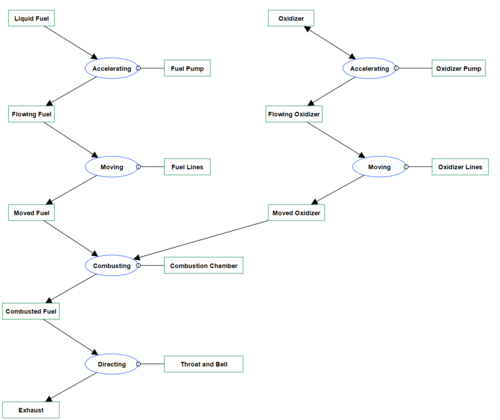
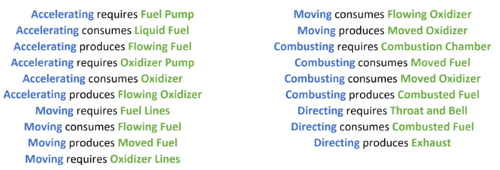
Design Structure Matrix (DSM) Allocation
Roadmap Model Using OPM
Solid Rocket Boosters
Solid rocket boosters are a comparatively simpler system. However, once ignition starts, there are no ways to stop the process. Ammonium perchlorate acts as the oxidizer, and aluminum powder acts as the fuel source.
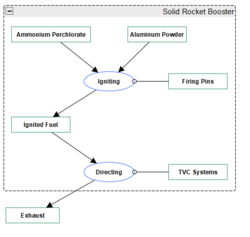
Examples of solid rocket boosters getting used in large quantities are the space shuttle and the lower stages of the Ariane-6 rocket.
Gas Generator Open-Cycle Engine
A gas generator open cycle engine is one of the simplest forms of liquid fueled rocket engines. In order to supply more fuel and oxidizer to the combustion chamber – which in turn increases pressure of combustion, and generally higher thrust – turbopumps are installed in the lines of the engine. The turbopumps are rotated by a small rocket engine called a preburner which is itself fueled by the same liquid fuel and oxygen. The spent preburner exhaust is directed outside of the main throat and bell as exhaust.
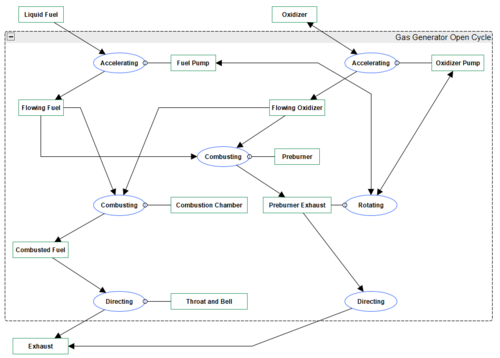
Examples of this style of rocket engine are the F-1 and the Merlin Engine.
Oxygen-rich, Closed-Cycle, Staged-Combustion Engine
An oxygen-rich, closed-cycle, staged-combustion engine is one of the more complex than open cycle gas turbine engines, but they are more efficient because they use more fuel and oxidizer in the main combustion chamber. In these engines, all oxidizer is pumped into the preburner, with some fuel. The remainder of the fuel is pumped directly to the main combustion chamber. The preburner exhaust is oxygen rich, and is pumped into the main combustion chamber where it supplies the required oxidizer for combustion.
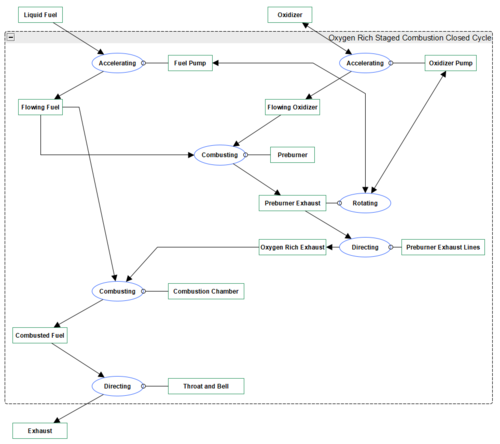
Examples of this style of rocket engine are the RD-180 and the BE-4.
Fuel-rich, Closed-Cycle, Staged-Combustion Engine
A fuel rich dual staged combustion closed cycle is similar in concept, but much more difficult in execution to the already complex oxygen rich staged combustion closed cycle engine. In the fuel rich closed cycle engine design, all of the fuel is sent to the two preburners, and the oxidizer is sent to the preburners as well as the main combustion chamber. Super-heated, fuel-rich exhaust is then directed from the preburner to the main combustion chamber. The advantage to this setup is that it is very efficient and generally has a high thrust to weight ratio as it is quite compact in its dimensions.
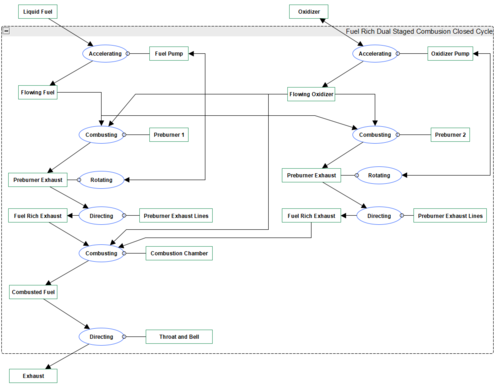
An example of this engine is the RS-25.
Full-flow, Closed-Cycle, Staged-Combustion Engine
Nuclear Engine
Figures of Merit
Tsiolkovsky Rocket Equation (m/s)
Δv = ve*ln(m0/mf)
- ve = effective exhaust velocity
- m0 = initial total mass including fuel and oxidizer
- mf = final mass without fuel and oxidizer
Specific Impulse (s)
Isp = ve/g0
- ve = average exhaust speed along the axis of the engine (either at sea level or vacuum)
- g0 = standard gravity in m/s2
Net Thrust (N)
Fn = M*Ve
- M = exhaust gas mass flow
- Ve = effective exhaust velocity
Thrust-to-weight ratio (N/kg)
TTW = Net Thrust (N)/m (kg)
- m = dry mass of the engine